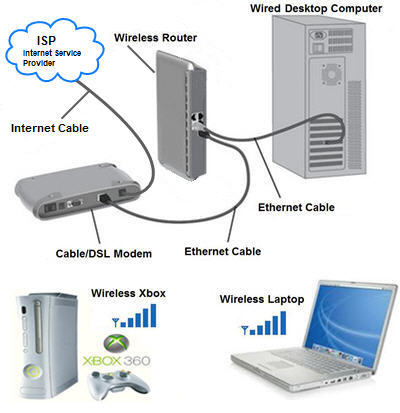
A Short
Beginners Intro
|
|
|
A home network setup is composed of multiple computer devices connected to each other in your house. The connections can be done through wire, wireless or a combination of both (normal for todays home networks) in your home. You may have a different combination of devices but once the network is set up you can add many more. Just keep in mind that they can be wired or wirelessly connected at any time and can be spread across multple rooms in your home.
 |
This is what a network might look like.
Here's just a short list of device
examples
that can be connected to your home network.
- Laptop (Notebook) Computer
- Desktop Computer
- Tablets: Apple iPad, Adroid, Windows 8 Surface
- Network Wireless Printers
- NAS ( Network Attached Storage)
- iPhone/iPod/Adroid/Blackberry
- Any WiFi Enabled Mobile Device
- WiFi Camera/Camcorder
- Game Boxes: XBox 360, XBox Live,PS3,Wii
- Home Theater Systems
- Smart LCD TV's
- DSL/Cable Modem
- Wired and Wireless Routers
They are all connected together in a home network by using network specific devices that includes modems, routers, switches, network cards, wireless adapters and cables. This type of network has components that are both wired and wirelessly connected together. The technology that is used for your home network is called Ethernet LAN Local Area Network.
It's a network that gives you fast network speed at a low cost. You can buy the network specicomponents you need to put together a home network setup from just about any store that sells computer equipment. That's almost everywhere these days.
Here's just a few more words on the network speed that you should expect from your home
network. The speed of an Ethernet home network can be 10Mbps,
100Mbps, and 1000Mbps for ethernet wired connected devices. Wireless connected devices will have speeds
of 11Mbps(B) 54Mbps(G), 150Mbps(N) and 300Mbps(N). Keep in mind that Mbps is Megabits per seconds
and the larger the number, the faster the network speed.
In most homes, speeds of 100Mbps for wired devices and 150Mps for wireless devices is normally
sufficient for your network needs. However, if you can spend a few dollars more I suggest you go for the fastest
speed you can afford.
Your Internet DSL/Cable modem is connected to your ISP Internet Service Provider and provides the you with Internet service. This inturn is connected to your router that shares and routes the Internet connection with your computers, gaming consoles and smart entertainment devices. This is done by connecting wired components up to phyisical ports on the back of your router. And wirelessly connecting components up to your router using wireless technology.
|